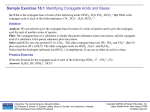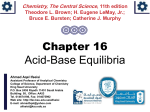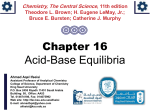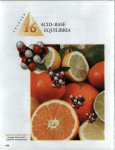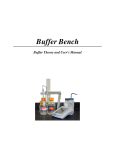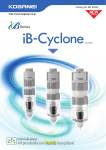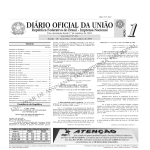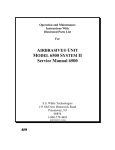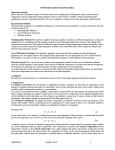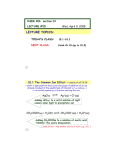Download "user manual"
Transcript
Chemistry, The Central Science, 10th edition Theodore L. Brown; H. Eugene LeMay, Jr.; and Bruce E. Bursten Chapter 16 Acids and Bases John D. Bookstaver St. Charles Community College St. Peters, MO 2006, Prentice Hall, Inc. Acids and Bases Acids & Bases • Acids: taste sour, litmus turns red • Bases: taste bitter, litmus turns blue, feel slippery • More H+ than OH- = acidic • More OH- than H+ = basic • When they react with each other; neutralization occurs Acids and Bases Some Definitions • Arrhenius Acid: Substance that, when dissolved in water, increases the concentration of hydrogen ions. Base: Substance that, when dissolved in water, increases the concentration of hydroxide ions. Acids and Bases Some Definitions • Brønsted–Lowry Acid: Proton donor Base: Proton acceptor Acids and Bases A Brønsted–Lowry acid… …must have a removable (acidic) proton. A Brønsted–Lowry base… …must have a pair of nonbonding electrons. Acids and Bases If it can be either… ...it is amphoteric. − HCO3 − HSO4 H 2O Acids and Bases What Happens When an Acid Dissolves in Water? • Water acts as a Brønsted–Lowry base and abstracts a proton (H+) from the acid. • As a result, the conjugate base of the acid and a hydronium ion are formed. Acids and Bases Conjugate Acids and Bases: • From the Latin word conjugare, meaning “to join together.” • Reactions between acids and bases always yield their conjugate bases and acids. Acids and Bases SAMPLE EXERCISE 16.1 Identifying Conjugate Acids and Bases (a) What is the conjugate base of each of the following acids: HClO 4, H2S, PH4+, HCO3– ? (b) What is the conjugate acid of each of the following bases: CN –, SO42–, H2O, HCO3– ? Solution Analyze: We are asked to give the conjugate base for each of a series of species and to give the conjugate acid for each of another series of species. Plan: The conjugate base of a substance is simply the parent substance minus one proton, and the conjugate acid of a substance is the parent substance plus one proton. Solve: (a) HClO4 less one proton (H+) is ClO4–. The other conjugate bases are HS–, PH3, and CO32–. (b) CN– plus one proton (H+) is HCN. The other conjugate acids are HSO4–, H3O+, and H2CO3. Notice that the hydrogen carbonate ion (HCO3–) is amphiprotic: It can act as either an acid or a base. PRACTICE EXERCISE Write the formula for the conjugate acid of each of the following: HSO 3–, F–, PO43–, CO. Answers: H2SO3, HF, HPO4 2–, HCO+ Acids and Bases SAMPLE EXERCISE 16.2 Writing Equations for Proton-Transfer Reactions The hydrogen sulfite ion (HSO3–) is amphoteric. (a) Write an equation for the reaction of HSO3– with water, in which the ion acts as an acid. (b) Write an equation for the reaction of HSO3– with water, in which the ion acts as a base. In both cases identify the conjugate acid-base pairs. Solution Analyze and Plan: We are asked to write two equations representing reactions between HSO 3– and water, one in which HSO3– should donate a proton to water, thereby acting as a Brønsted–Lowry acid, and one in which HSO3– should accept a proton from water, thereby acting as a base. We are also asked to identify the conjugate pairs in each equation. Solve: (a) The conjugate pairs in this equation are HSO3– (acid) and SO32– (conjugate base); and H2O (base) and H3O+ (conjugate acid). (b) The conjugate pairs in this equation are H2O (acid) and OH– (conjugate base), and HSO3– (base) and H2SO3 (conjugate acid). PRACTICE EXERCISE When lithium oxide (Li2O) is dissolved in water, the solution turns basic from the reaction of the oxide ion (O 2–) with water. Write the reaction that occurs, and identify the conjugate acid-base pairs. Acids 2– – Answer: is the conjugate acid of the base O . OH isand also the conjugate base of the acid H2O. Bases Acid and Base Strength • Strong acids are completely dissociated in water. Their conjugate bases are quite weak. • Weak acids only dissociate partially in water. Their conjugate bases are weak bases. Acids and Bases Acid and Base Strength • Substances with negligible acidity do not dissociate in water. Their conjugate bases are exceedingly strong. Acids and Bases Acid and Base Strength In any acid-base reaction, the equilibrium will favor the reaction that moves the proton to the stronger base. HCl(aq) + H2O(l) H3O+(aq) + Cl−(aq) H2O is a much stronger base than Cl−, so the equilibrium lies so far to the right K is not measured (K>>1). Acids and Bases Acid and Base Strength C2H3O2(aq) + H2O(l) H3O+(aq) + C2H3O2−(aq) Acetate is a stronger base than H2O, so the equilibrium favors the left side (K<1). Acids and Bases SAMPLE EXERCISE 16.3 Predicting the Position of a Proton-Transfer Equilibrium For the following proton-transfer reaction, use Figure 16.4 to predict whether the equilibrium lies predominantly to the left (that is, Kc < 1) or to the right (Kc > 1): Solution Analyze: We are asked to predict whether the equilibrium shown lies to the right, favoring products, or to the left, favoring reactants. Plan: This is a proton-transfer reaction, and the position of the equilibrium will favor the proton going to the stronger of two bases. The two bases in the equation are CO 32–, the base in the forward reaction as written, and SO42–, the conjugate base of HSO4–. We can find the relative positions of these two bases in Figure 16.4 to determine which is the stronger base. Solve: CO32– appears lower in the right-hand column in Figure 16.4 and is therefore a stronger base than SO42–. CO32–, therefore, will get the proton preferentially to become HCO 3–, while SO42– will remain mostly unprotonated. The resulting equilibrium will lie to the right, favoring products (that is, Kc > 1). Comment: Of the two acids in the equation, HSO4– and HCO3–, the stronger one gives up a proton while the weaker one retains its proton. Thus, the equilibrium favors the direction in which the proton moves from the stronger acid and becomes bonded to the stronger base. Acids and Bases SAMPLE EXERCISE 16.3 continued PRACTICE EXERCISE For each of the following reactions, use Figure 16.4 to predict whether the equilibrium lies predominantly to the left or to the right: Answers: (a) left, (b) right Acids and Bases Autoionization of Water • As we have seen, water is amphoteric. • In pure water, a few molecules act as bases and a few act as acids. H2O(l) + H2O(l) H3O+(aq) + OH−(aq) • This is referred to as autoionization. Acids and Bases Ion-Product Constant • The equilibrium expression for this process is Kc = [H3O+] [OH−] • This special equilibrium constant is referred to as the ion-product constant for water, Kw. • At 25°C, Kw = 1.0 10−14 Acids and Bases SAMPLE EXERCISE 16.4 Calculating [H+] for Pure Water Calculate the values of [H+] and [OH–] in a neutral solution at 25°C. Solution Analyze: We are asked to determine the concentrations of hydronium and hydroxide ions in a neutral solution at 25°C. Plan: We will use Equation 16.16 and the fact that, by definition, [H+] = [OH–] in a neutral solution. Solve: We will represent the concentration of [H+] and [OH–] in neutral solution with x. This gives In an acid solution [H+] is greater than 1.0 10–7 M ; in a basic solution [H+] is less than 1.0 0–7 M. PRACTICE EXERCISE Indicate whether solutions with each of the following ion concentrations are neutral, acidic, or basic: (a) [H+] = 4 10–9 M; (b) [OH–] = 1 10–7 M; (c) [OH–] = 7 10–13M. Answers: (a) basic, (b) neutral, (c) acidic Acids and Bases SAMPLE EXERCISE 16.5 Calculating [H+] from [OH–] Calculate the concentration of H+ (aq) in (a) a solution in which [OH–] is 0.010 M, (b) a solution in which [OH–] is 1.8 10–9 M. Note: In this problem and all that follow, we assume, unless stated otherwise, that the temperature is 25°C. Solution Analyze: We are asked to calculate the hydronium ion concentration in an aqueous solution where the hydroxide concentration is known. Plan: We can use the equilibrium-constant expression for the autoionization of water and the value of Kw to solve for each unknown concentration. Solve: (a) Using Equation 16.16, we have: This solution is basic because (b) In this instance This solution is acidic because Acids and Bases SAMPLE EXERCISE 16.5 continued PRACTICE EXERCISE Calculate the concentration of OH–(aq) in a solution in which (a) [H+] = 2 = 100 [OH–]. Answers: (a) 5 10–9 M, (b) 1.0 10–7 M, (c) 1.0 10–6 M; (b) [H+] = [OH–]; (c) [H+] 10–8 M Acids and Bases pH pH is defined as the negative base-10 logarithm of the hydronium ion concentration. pH = −log [H3O+] Acids and Bases pH • In pure water, Kw = [H3O+] [OH−] = 1.0 10−14 • Because in pure water [H3O+] = [OH−], [H3O+] = (1.0 10−14)1/2 = 1.0 10−7 Acids and Bases pH • Therefore, in pure water, pH = −log (1.0 10−7) = 7.00 • An acid has a higher [H3O+] than pure water, so its pH is <7 • A base has a lower [H3O+] than pure water, so its pH is >7. Acids and Bases pH These are the pH values for several common substances. Acids and Bases SAMPLE EXERCISE 16.6 Calculating pH from [H+] Calculate the pH values for the two solutions described in Sample Exercise 16.5. Solution Analyze: We are asked to determine the pH of aqueous solutions for which we have already calculated [H+]. Plan: We can use the benchmarks in Figure 16.5 to determine the pH for part (a) and to estimate pH for part (b). We can then use Equation 16.17 to calculate pH for part (b). Solve: (a) In the first instance we found [H+] to be 1.0 10–12 M. Although we can use Equation 16.17 to determine the pH, 1.0 10–12 is one of the benchmarks in Figure 16.5, so the pH can be determined without any formal calculation. pH = –log(1.0 10–12 ) = –(–12.00) = 12.00 The rule for using significant figures with logs is that the number of decimal places in the log equals the number of significant figures in the original number (see Appendix A). Because 1.0 10–12 has two significant figures, the pH has two decimal places, 12.00. (b) For the second solution, [H+] = 5.6 10–6 M. Before performing the calculation, it is helpful to estimate the pH. To do so, we note that [H+] lies between 1 10–6 and 1 10–5. 1 10–6 < 5.6 10–6 < 1 10–5 Thus, we expect the pH to lie between 6.0 and 5.0. We use Equation 16.17 to calculate the pH. pH = –log (5.6 10–6 ) = 5.25 Acids and Bases SAMPLE EXERCISE 16.6 continued Check: After calculating a pH, it is useful to compare it to your prior estimate. In this case the pH, as we predicted, falls between 6 and 5. Had the calculated pH and the estimate not agreed, we should have reconsidered our calculation or estimate or both. Note that although [H+] lies halfway between the two benchmark concentrations, the calculated pH does not lie halfway between the two corresponding pH values. This is because the pH scale is logarithmic rather than linear. PRACTICE EXERCISE (a) In a sample of lemon juice [H+] is 3.8 10–4 M. What is the pH? (b) A commonly available window-cleaning solution has a [H+] of 5.3 10–9 M. What is the pH? Answers: (a) 3.42, (b) 8.28 Acids and Bases SAMPLE EXERCISE 16.7 Calculating [H+] from pH A sample of freshly pressed apple juice has a pH of 3.76. Calculate [H+]. Solution Analyze: We need to calculate [H+] from pH. Plan: We will use Equation 16.17, pH = –log [H+], for the calculation. Solve: From Equation 16.17, we have Thus, To find [H+], we need to determine the antilog of –3.76. Scientific calculators have an antilog function (sometimes labeled INV log or 10x) that allows us to perform the calculation: Comment: Consult the user’s manual for your calculator to find out how to perform the antilog operation. The number of significant figures in [H+] is two because the number of decimal places in the pH is two. Check: Because the pH is between 3.0 and 4.0, we know that [H+] will be between 1 10–3 and 1 10–4 M. Our calculated [H+] falls within this estimated range. PRACTICE EXERCISE A solution formed by dissolving an antacid tablet has a pH of 9.18. Calculate [H+]. Answer: [H+] = 6.6 10–10 M Acids and Bases SAMPLE EXERCISE 16.8 Calculating the pH of a Strong Acid What is the pH of a 0.040 M solution of HClO4? Solution Analyze and Plan: We are asked to calculate the pH of a 0.040 M solution of HClO4. Because HClO4 is a strong acid, it is completely ionized, giving [H+] = [ClO4–] = 0.040 M. Because [H+] lies between benchmarks 1 10–2 and 1 10–1 in Figure 16.5, we estimate that the pH will be between 2.0 and 1.0. Solve: The pH of the solution is given by pH = –log(0.040) = 1.40. Check: Our calculated pH falls within the estimated range. PRACTICE EXERCISE An aqueous solution of HNO3 has a pH of 2.34. What is the concentration of the acid? Answer: 0.0046 M Acids and Bases Other “p” Scales • The “p” in pH tells us to take the negative log of the quantity (in this case, hydrogen ions). • Some similar examples are pOH −log [OH−] pKw −log Kw Acids and Bases Watch This! Because [H3O+] [OH−] = Kw = 1.0 we know that 10−14, −log [H3O+] + −log [OH−] = −log Kw = 14.00 or, in other words, pH + pOH = pKw = 14.00 Acids and Bases SAMPLE EXERCISE 16.9 Calculating the pH of a Strong Base What is the pH of (a) a 0.028 M solution of NaOH, (b) a 0.0011 M solution of Ca(OH)2? Solution Analyze: We’re asked to calculate the pH of two solutions, given the concentration of strong base for each. Plan: We can calculate each pH by two equivalent methods. First, we could use Equation 16.16 to calculate [H+] and then use Equation 16.17 to calculate the pH. Alternatively, we could use [OH–] to calculate pOH and then use Equation 16.20 to calculate the pH. Solve: (a) NaOH dissociates in water to give one OH– ion per formula unit. Therefore, the OH– concentration for the solution in (a) equals the stated concentration of NaOH, namely 0.028 M. (b) Ca(OH)2 is a strong base that dissociates in water to give two OH– ions per formula unit. Thus, the concentration of OH–(aq) for the solution in part (b) is 2 (0.0011M) = 0.0022 M. Acids and Bases SAMPLE EXERCISE 16.9 continued PRACTICE EXERCISE What is the concentration of a solution of (a) KOH for which the pH is 11.89; (b) Ca(OH)2 for which the pH is 11.68? Answers: (a) 7.8 10–3 M, (b) 2.4 10–13 M Acids and Bases How Do We Measure pH? • For less accurate measurements, one can use Litmus paper • “Red” paper turns blue above ~pH = 8 • “Blue” paper turns red below ~pH = 5 An indicator Acids and Bases How Do We Measure pH? For more accurate measurements, one uses a pH meter, which measures the voltage in the solution. Acids and Bases Strong Acids • You will recall that the seven strong acids are HCl, HBr, HI, HNO3, H2SO4, HClO3, and HClO4. • These are, by definition, strong electrolytes and exist totally as ions in aqueous solution. • For the monoprotic strong acids, [H3O+] = [acid]. Acids and Bases Strong Bases • Strong bases are the soluble hydroxides, which are the alkali metal and heavier alkaline earth metal hydroxides (Ca2+, Sr2+, and Ba2+). • Again, these substances dissociate completely in aqueous solution. Acids and Bases Dissociation Constants • For a generalized acid dissociation, HA(aq) + H2O(l) A−(aq) + H3O+(aq) the equilibrium expression would be [H3O+] [A−] Kc = [HA] • This equilibrium constant is called the acid-dissociation constant, Ka. Acids and Bases Dissociation Constants The greater the value of Ka, the stronger the acid. Acids and Bases Calculating Ka from the pH • The pH of a 0.10 M solution of formic acid, HCOOH, at 25°C is 2.38. Calculate Ka for formic acid at this temperature. • We know that [H3O+] [COO−] Ka = [HCOOH] Acids and Bases Calculating Ka from the pH • The pH of a 0.10 M solution of formic acid, HCOOH, at 25°C is 2.38. Calculate Ka for formic acid at this temperature. • To calculate Ka, we need the equilibrium concentrations of all three things. • We can find [H3O+], which is the same as [HCOO−], from the pH. Acids and Bases Calculating Ka from the pH pH = −log [H3O+] 2.38 = −log [H3O+] −2.38 = log [H3O+] 10−2.38 = 10log [H3O+] = [H3O+] 4.2 10−3 = [H3O+] = [HCOO−] Acids and Bases Calculating Ka from pH Now we can set up a table… [HCOOH], M Initially Change At Equilibrium [H3O+], M [HCOO−], M 0.10 −4.2 10-3 0.10 − 4.2 10−3 = 0.0958 = 0.10 0 +4.2 4.2 0 10-3 +4.2 10−3 4.2 10−3 10−3 Acids and Bases Calculating Ka from pH Ka = [4.2 = 1.8 10−3] [4.2 [0.10] 10−3] 10−4 Acids and Bases Calculating Percent Ionization [H3O+]eq • Percent Ionization = [HA] initial 100 • In this example [H3O+]eq = 4.2 10−3 M [HCOOH]initial = 0.10 M Acids and Bases Calculating Percent Ionization 4.2 10−3 Percent Ionization = 100 0.10 = 4.2% Acids and Bases SAMPLE EXERCISE 16.10 Calculating Ka and Percent Ionization from Measured pH A student prepared a 0.10 M solution of formic acid (HCHO2) and measured its pH using a pH meter of the type illustrated in Figure 16.6. The pH at 25°C was found to be 2.38. (a) Calculate Ka for formic acid at this temperature. (b) What percentage of the acid is ionized in this 0.10 M solution? Solution Analyze: We are given the molar concentration of an aqueous solution of weak acid and the pH of the solution at 25°C, and we are asked to determine the value of Ka for the acid and the percentage of the acid that is ionized. Plan: Although we are dealing specifically with the ionization of a weak acid, this problem is very similar to the equilibrium problems we encountered in Chapter 15. We can solve it using the method first outlined in Sample Exercise 15.8, starting with the chemical reaction and a tabulation of initial and equilibrium concentrations. Solve: (a) The first step in solving any equilibrium problem is to write the equation for the equilibrium reaction. The ionization equilibrium for formic acid can be written as follows: The equilibrium-constant expression is From the measured pH, we can calculate [H+]: Acids and Bases SAMPLE EXERCISE 16.10 continued We can do a little accounting to determine the concentrations of the species involved in the equilibrium. We imagine that the solution is initially 0.10 M in HCHO2 molecules. We then consider the ionization of the acid into H+ and CHO2–. For each HCHO2 molecule that ionizes, one H+ ion and one CHO2– ion are produced in solution. Because the pH measurement indicates that [H+] = 4.2 10–3 M at equilibrium, we can construct the following table: Notice that we have neglected the very small concentration of H+(aq) that is due to the autoionization of H2O. Notice also that the amount of HCHO2 that ionizes is very small compared with the initial concentration of the acid. To the number of significant figures we are using, the subtraction yields 0.10 M: We can now insert the equilibrium concentrations into the expression for Ka : Check: The magnitude of our answer is reasonable because Ka for a weak acid is usually between 10–3 and Acids 10–10. and Bases SAMPLE EXERCISE 16.10 continued (b) The percentage of acid that ionizes is given by the concentration of H+ or CHO2– at equilibrium, divided by the initial acid concentration, multiplied by 100%. PRACTICE EXERCISE Niacin, one of the B vitamins, has the following molecular structure: A 0.020 M solution of niacin has a pH of 3.26. (a) What percentage of the acid is ionized in this solution? (b) What is the acid-dissociation constant, Ka, for niacin? Answers: (a) 2.7%, (b) 1.5 10–5 Acids and Bases Calculating pH from Ka Calculate the pH of a 0.30 M solution of acetic acid, HC2H3O2, at 25°C. HC2H3O2(aq) + H2O(l) H3O+(aq) + C2H3O2−(aq) Ka for acetic acid at 25°C is 1.8 10−5. Acids and Bases Calculating pH from Ka The equilibrium constant expression is [H3O+] [C2H3O2−] Ka = [HC2H3O2] Acids and Bases Calculating pH from Ka We next set up a table… [C2H3O2], M [H3O+], M [C2H3O2−], M Initially 0.30 0 0 Change −x +x +x x x At Equilibrium 0.30 − x 0.30 We are assuming that x will be very small compared to 0.30 and can, therefore, be ignored. Acids and Bases Calculating pH from Ka Now, 1.8 (1.8 2 (x) 10−5 = (0.30) 10−5) (0.30) = x2 5.4 10−6 = x2 2.3 10−3 = x Acids and Bases Calculating pH from Ka pH = −log [H3O+] pH = −log (2.3 10−3) pH = 2.64 Acids and Bases SAMPLE EXERCISE 16.11 Using Ka to Calculate pH Calculate the pH of a 0.20 M solution of HCN. (Refer to Table 16.2 or Appendix D for the value of Ka.) Solution Analyze: We are given the molarity of a weak acid and are asked for the pH. From Table 16.2, Ka for HCN is 10–10. Plan: We proceed as in the example just worked in the text, writing the chemical equation and constructing a table of initial and equilibrium concentrations in which the equilibrium concentration of H+ is our unknown. 4.9 Solve: Writing both the chemical equation for the ionization reaction that forms H+(aq) and the equilibriumconstant (Ka) expression for the reaction: Next, we tabulate the concentration of the species involved in the equilibrium reaction, letting x = [H+] at equilibrium: Acids and Bases SAMPLE EXERCISE 16.11 continued Substituting the equilibrium concentrations from the table into the equilibrium-constant expression yields We next make the simplifying approximation that x, the amount of acid that dissociates, is small compared with the initial concentration of acid; that is, Thus Solving for x, we have A concentration of 9.9 10–6 M is much smaller than 5% of 0.20, the initial HCN concentration. Our simplifying approximation is therefore appropriate. We now calculate the pH of the solution: PRACTICE EXERCISE The Ka for niacin (Practice Exercise 16.10) is 1.5 Answer: 3.42 10–5. What is the pH of a 0.010 M solution of niacin? Acids and Bases SAMPLE EXERCISE 16.12 Using Ka to Calculate Percent Ionization Calculate the percentage of HF molecules ionized in (a) a 0.10 M HF solution, (b) a 0.010 M HF solution. Solution Analyze: We are asked to calculate the percent ionization of two HF solutions of different concentration. Plan: We approach this problem as we would previous equilibrium problems. We begin by writing the chemical equation for the equilibrium and tabulating the known and unknown concentrations of all species. We then substitute the equilibrium concentrations into the equilibrium-constant expression and solve for the unknown concentration, that of H+. Solve: (a) The equilibrium reaction and equilibrium concentrations are as follows: The equilibrium-constant expression is When we try solving this equation using the approximation 0.10 – x = 0.10 (that is, by neglecting the concentration of acid that ionizes in comparison with the initial concentration), we obtain Acids and Bases SAMPLE EXERCISE 16.12 continued Because this value is greater than 5% of 0.10 M, we should work the problem without the approximation, using an equation-solving calculator or the quadratic formula. Rearranging our equation and writing it in standard quadratic form, we have This equation can be solved using the standard quadratic formula. Substituting the appropriate numbers gives Of the two solutions, only the one that gives a positive value for x is chemically reasonable. Thus, Acids and Bases SAMPLE EXERCISE 16.12 continued From our result, we can calculate the percent of molecules ionized: (b) Proceeding similarly for the 0.010 M solution, we have Solving the resultant quadratic expression, we obtain The percentage of molecules ionized is Comment: Notice that if we do not use the quadratic formula to solve the problem properly, we calculate 8.2% ionization for (a) and 26% ionization for (b). Notice also that in diluting the solution by a factor of 10, the percentage of molecules ionized increases by a factor of 3. This result is in accord with what we see in Figure 16.9. It is also what we would expect from Le Châtelier’s principle. • (Section 15.6) There are more Acids “particles” or reaction components on the right side of the equation than on the left. Dilution causes the reaction and to shift in the direction of the larger number of particles because this counters the effect of the decreasing Bases concentration of particles. SAMPLE EXERCISE 16.12 continued PRACTICE EXERCISE In Practice Exercise 16.10, we found that the percent ionization of niacin (Ka = 1.5 10–5) in a 0.020 M solution is 2.7%. Calculate the percentage of niacin molecules ionized in a solution that is (a) 0.010 M, (b) 1.0 10–3 M. Answers: (a) 3.8%, (b) 12% Acids and Bases Polyprotic Acids • Have more than one acidic proton. • If the difference between the Ka for the first dissociation and subsequent Ka values is 103 or more, the pH generally depends only on the first dissociation. Acids and Bases SAMPLE EXERCISE 16.13 Calculating the pH of a Polyprotic Acid Solution The solubility of CO2 in pure water at 25°C and 0.1 atm pressure is 0.0037 M. The common practice is to assume that all of the dissolved CO2 is in the form of carbonic acid (H2CO3), which is produced by reaction between the CO2 and H2O: What is the pH of a 0.0037 M solution of H2CO3? Solution Analyze: We are asked to determine the pH of a 0.0037 M solution of a polyprotic acid. Plan: H2CO3 is a diprotic acid; the two acid-dissociation constants, Ka1 and Ka2 (Table 16.3), differ by more than a factor of 103. Consequently, the pH can be determined by considering only Ka1, thereby treating the acid as if it were a monoprotic acid. Solve: Proceeding as in Sample Exercises 16.11 and 16.12, we can write the equilibrium reaction and equilibrium concentrations as follows: The equilibrium-constant expression is as follows: Acids and Bases SAMPLE EXERCISE 16.13 continued Solving this equation using an equation-solving calculator, we get Alternatively, because Ka1 is small, we can make the simplifying approximation that x is small, so that Thus, Solving for x, we have The small value of x indicates that our simplifying assumption was justified. The pH is therefore Comment: If we were asked to solve for [CO32–], we would need to use Ka2. Let’s illustrate that calculation. Using the values of [HCO3–] and [H+] calculated above, and setting [CO32–] = y, we have the following initial and equilibrium concentration values: Acids and Bases SAMPLE EXERCISE 16.13 continued Assuming that y is small compared to 4.0 10–5, we have The value calculated for y is indeed very small compared to 4.0 10–5, showing that our assumption was justified. It also shows that the ionization of HCO3– is negligible compared to that of H2CO3, as far as production of H+ is concerned. However, it is the only source of CO32–, which has a very low concentration in the solution. Our calculations thus tell us that in a solution of carbon dioxide in water, most of the CO 2 is in the form of CO2 or H2CO3, a small fraction ionizes to form H+ and HCO3–, and an even smaller fraction ionizes to give CO 32–. Notice also that [CO32–] is numerically equal to Ka2. PRACTICE EXERCISE (a) Calculate the pH of a 0.020 M solution of oxalic acid (H2C2O4). (See Table 16.3 for Ka1 and Ka2.) (b) Calculate the concentration of oxalate ion, [C2O42–], in this solution. Answers: (a) pH = 1.80, (b) [C2O42–] = 6.4 10–5 M Acids and Bases Weak Bases Bases react with water to produce hydroxide ion. Acids and Bases Weak Bases The equilibrium constant expression for this reaction is [HB] [OH−] Kb = [B−] where Kb is the base-dissociation constant. Acids and Bases SAMPLE EXERCISE 16.14 Using Kb to Calculate [OH–] Calculate the concentration of OH– in a 0.15 M solution of NH3. Solution Analyze: We are given the concentration of a weak base and are asked to determine the concentration of OH– . Plan: We will use essentially the same procedure here as used in solving problems involving the ionization of weak acids; that is, we write the chemical equation and tabulate initial and equilibrium concentrations. Solve: We first write the ionization reaction and the corresponding equilibrium-constant (Kb) expression: We then tabulate the equilibrium concentrations involved in the equilibrium: (We ignore the concentration of H2O because it is not involved in the equilibrium-constant expression.) Inserting these quantities into the equilibrium-constant expression gives the following: Acids and Bases SAMPLE EXERCISE 16.14 continued Because Kb is small, we can neglect the small amount of NH3 that reacts with water, as compared to the total NH3 concentration; that is, we can neglect x relative to 0.15 M. Then we have Check: The value obtained for x is only about 1% of the NH3 concentration, 0.15 M. Therefore, neglecting x relative to 0.15 was justified. PRACTICE EXERCISE Which of the following compounds should produce the highest pH as a 0.05 M solution: pyridine, methylamine, or nitrous acid? Answer: methylamine (because it has the largest Kb value) Acids and Bases Weak Bases Kb can be used to find [OH−] and, through it, pH. Acids and Bases pH of Basic Solutions What is the pH of a 0.15 M solution of NH3? NH3(aq) + H2O(l) NH4+(aq) + OH−(aq) [NH4+] [OH−] Kb = = 1.8 [NH3] 10−5 Acids and Bases pH of Basic Solutions Tabulate the data. [NH3], M Initially At Equilibrium 0.15 0.15 - x 0.15 [NH4+], M [OH−], M 0 0 x x Acids and Bases pH of Basic Solutions 1.8 (1.8 2 (x) 10−5 = (0.15) 10−5) (0.15) = x2 2.7 10−6 = x2 1.6 10−3 = x2 Acids and Bases pH of Basic Solutions Therefore, [OH−] = 1.6 10−3 M pOH = −log (1.6 10−3) pOH = 2.80 pH = 14.00 − 2.80 pH = 11.20 Acids and Bases SAMPLE EXERCISE 16.15 Using pH to Determine the Concentration of a Salt A solution made by adding solid sodium hypochlorite (NaClO) to enough water to make 2.00 L of solution has a pH of 10.50. Using the information in Equation 16.37, calculate the number of moles of NaClO that were added to the water. Solution Analyze: We are given the pH of a 2.00-L solution of NaClO and must calculate the number of moles of NaClO needed to raise the pH to 10.50. NaClO is an ionic compound consisting of Na + and ClO– ions. As such, it is a strong electrolyte that completely dissociates in solution into Na + ,which is a spectator ion, and ClO– ion, which is a weak base with Kb = 3.33 10–7 (Equation 16.37). Plan: From the pH, we can determine the equilibrium concentration of OH–. We can then construct a table of initial and equilibrium concentrations in which the initial concentration of ClO – is our unknown. We can calculate [ClO–] using the equilibrium-constant expression, Kb. Solve: We can calculate [OH–] by using either Equation 16.16 or Equation 16.19; we will use the latter method here: This concentration is high enough that we can assume that Equation 16.37 is the only source of OH –; that is, we can neglect any OH– produced by the autoionization of H2O. We now assume a value of x for the initial concentration of ClO– and solve the equilibrium problem in the usual way. Acids and Bases SAMPLE EXERCISE 16.15 continued We now use the expression for the base-dissociation constant to solve for x: Thus We say that the solution is 0.30 M in NaClO, even though some of the ClO– ions have reacted with water. Because the solution is 0.30 M in NaClO and the total volume of solution is 2.00 L, 0.60 mol of NaClO is the amount of the salt that was added to the water. PRACTICE EXERCISE A solution of NH3 in water has a pH of 11.17. What is the molarity of the solution? Answer: 0.12 M Acids and Bases Ka and Kb Ka and Kb are related in this way: Ka Kb = Kw Therefore, if you know one of them, you can calculate the other. Acids and Bases SAMPLE EXERCISE 16.16 Calculating Ka or Kb for a Conjugate Acid-Base Pair Calculate (a) the base-dissociation constant, Kb, for the fluoride ion (F–); (b) the acid-dissociation constant, Ka, for the ammonium ion (NH4+). Solution Analyze: We are asked to determine dissociation constants for F–, the conjugate base of HF, and NH4+, the conjugate acid of NH3. Plan: Although neither F– nor NH4+ appears in the tables, we can find the tabulated values for ionization constants for HF and NH3, and use the relationship between Ka and Kb to calculate the ionization constants for each of the conjugates. Solve: (a) Ka for the weak acid, HF, is given in Table 16.2 and Appendix D as Ka = 6.8 10–4 . We can use Equation 16.40 to calculate Kb for the conjugate base, F–: (b) Kb for NH3 is listed in Table 16.4 and in Appendix D as Kb = 1.8 calculate Ka for the conjugate acid, NH4+: 10–5. Using Equation 16.40, we can Acids and Bases SAMPLE EXERCISE 16.16 continued PRACTICE EXERCISE (a) Which of the following anions has the largest base-dissociation constant: NO2–, PO43– , or N3– ? (b) The base quinoline has the following structure: Its conjugate acid is listed in handbooks as having a pKa of 4.90. What is the base-dissociation constant for quinoline? Answers: (a) PO43–(Kb = 2.4 10–2), (b) 7.9 10–10 Acids and Bases Reactions of Anions with Water • Anions are bases. • As such, they can react with water in a hydrolysis reaction to form OH− and the conjugate acid: X−(aq) + H2O(l) HX(aq) + OH−(aq) Acids and Bases Reactions of Cations with Water • Cations with acidic protons (like NH4+) will lower the pH of a solution. • Most metal cations that are hydrated in solution also lower the pH of the solution. Acids and Bases Reactions of Cations with Water • Attraction between nonbonding electrons on oxygen and the metal causes a shift of the electron density in water. • This makes the O-H bond more polar and the water more acidic. • Greater charge and smaller size make a cation more acidic. Acids and Bases Effect of Cations and Anions 1. An anion that is the conjugate base of a strong acid will not affect the pH. 2. An anion that is the conjugate base of a weak acid will increase the pH. 3. A cation that is the conjugate acid of a weak base will decrease the pH. Acids and Bases Effect of Cations and Anions 4. Cations of the strong Arrhenius bases will not affect the pH. 5. Other metal ions will cause a decrease in pH. 6. When a solution contains both the conjugate base of a weak acid and the conjugate acid of a weak base, the affect on pH depends on the Ka and Kb values. Acids and Bases SAMPLE EXERCISE 16.17 Predicting the Relative Acidity of Salt Solutions List the following solutions in order of increasing pH: (i) 0.1 M Ba(C2H3O2)2, (ii) 0.1 M NH4Cl, (iii) 0.1 M NH3CH3Br, (iv) 0.1 M KNO3. Solution Analyze: We are asked to arrange a series of salt solutions in order of increasing pH (that is, from the most acidic to the most basic). Plan: We can determine whether the pH of a solution is acidic, basic, or neutral by identifying the ions in solution and by assessing how each ion will affect the pH. Solve: Solution (i) contains barium ions and acetate ions. Ba2+ is an ion of one of the heavy alkaline earth metals and will therefore not affect the pH (summary point 4). The anion, C 2H3O2–, is the conjugate base of the weak acid HC2H3O2 and will hydrolyze to produce OH– ions, thereby making the solution basic (summary point 2). Solutions (ii) and (iii) both contain cations that are conjugate acids of weak bases and anions that are conjugate bases of strong acids. Both solutions will therefore be acidic. Solution (i) contains NH4+, which is the conjugate acid of NH3 (Kb = 1.8 10–5). Solution (iii) contains NH3CH3+, which is the conjugate acid of NH2CH3 (Kb = 4.4 10–4). Because NH3 has the smaller Kb and is the weaker of the two bases, NH4+ will be the stronger of the two conjugate acids. Solution (ii) will therefore be the more acidic of the two. Solution (iv) contains the K+ ion, which is the cation of the strong base KOH, and the NO 3– ion, which is the conjugate base of the strong acid HNO3. Neither of the ions in solution (iv) will react with water to any appreciable extent, making the solution neutral. Thus, the order of pH is 0.1 M NH4Cl < 0.1 M NH3CH3Br < 0.1 M KNO3 < 0.1 M Ba(C2H3O2)2. PRACTICE EXERCISE In each of the following, indicate which salt will form the more acidic (or less basic) 0.010 M solution: (a) NaNO3, Fe(NO3)3; (b) KBr, KBrO; (c) CH3NH3Cl, BaCl2, (d) NH4NO2, NH4NO3. Answers: (a) Fe(NO3)3, (b) KBr, (c) CH3NH3Cl, (d) NH4NO3 Acids and Bases SAMPLE EXERCISE 16.18 Predicting Whether the Solution of an Amphiprotic Anion is Acidic or Basic Predict whether the salt Na2HPO4 will form an acidic solution or a basic solution on dissolving in water. Solution Analyze: We are asked to predict whether a solution of Na2HPO4 will be acidic or basic. This substance is an ionic compound composed of Na+ and HPO42– ions. Plan: We need to evaluate each ion, predicting whether each is acidic or basic. Because Na + is the cation of a strong base, NaOH, we know that Na+ has no influence on pH. It is merely a spectator ion in acid-base chemistry. Thus, our analysis of whether the solution is acidic or basic must focus on the behavior of the HPO 42– ion. We need to consider the fact that HPO42– can act as either an acid or a base. The reaction with the larger equilibrium constant will determine whether the solution is acidic or basic. Solve: The value of Ka for Equation 16.45, as shown in Table 16.3, is 4.2 10–13. We must calculate the value of Kb for Equation 16.46 from the value of Ka for its conjugate acid, H2PO4–. We make use of the relationship shown in Equation 16.40. Ka Kb = Kw We want to know Kb for the base HPO42–, knowing the value of Ka for the conjugate acid H2PO4– : Kb(HPO42–) Ka(HPO4–) = Kw = 1.0 10–14 Acids Because Ka for H2PO4 is 6.2 (Table 16.3), we calculate Kb for HPO4 to be 1.6 This is more than and 5 2– 10 times larger than Ka for HPO4 ; thus, the reaction shown in Equation 16.46 predominates over that in Bases Equation 16.45, and the solution will be basic. – 10–8 2– 10–7. SAMPLE EXERCISE 16.18 continued PRACTICE EXERCISE Predict whether the dipotassium salt of citric acid (K2HC6H5O7) will form an acidic or basic solution in water (see Table 16.3 for data). Answer: acidic Acids and Bases Factors Affecting Acid Strength • The more polar the H-X bond and/or the weaker the H-X bond, the more acidic the compound. • Acidity increases from left to right across a row and from top to bottom down a group. Acids and Bases Factors Affecting Acid Strength In oxyacids, in which an OH is bonded to another atom, Y, the more electronegative Y is, the more acidic the acid. Acids and Bases Factors Affecting Acid Strength For a series of oxyacids, acidity increases with the number of oxygens. Acids and Bases Factors Affecting Acid Strength Resonance in the conjugate bases of carboxylic acids stabilizes the base and makes the conjugate acid more acidic. Acids and Bases SAMPLE EXERCISE 16.19 Predicting Relative Acidities from Composition and Structure Arrange the compounds in each of the following series in order of increasing acid strength: (a) AsH3, HI, NaH, H2O; (b) H2SeO3, H2SeO4, H2O. Solution Analyze: We are asked to arrange two sets of compounds in order from weakest acid to strongest acid. Plan: For the binary acids in part (a), we will consider the electronegativities of As, I, Na, and O, respectively. For the oxyacids in part (b), we will consider the number of oxygen atoms bonded to the central atom and the similarities between the Se-containing compounds and some more familiar acids. Solve: (a) The elements from the left side of the periodic table form the most basic binary hydrogen compounds because the hydrogen in these compounds carries a negative charge. Thus NaH should be the most basic compound on the list. Because arsenic is less electronegative than oxygen, we might expect that AsH 3 would be a weak base toward water. That is also what we would predict by an extension of the trends shown in Figure 16.13. Further, we expect that the binary hydrogen compounds of the halogens, as the most electronegative element in each period, will be acidic relative to water. In fact, HI is one of the strong acids in water. Thus the order of increasing acidity is NaH < AsH3 < H2O < HI. (b) The acidity of oxyacids increases as the number of oxygen atoms bonded to the central atom increases. Thus, H2SeO4 will be a stronger acid than H2SeO3; in fact, the Se atom in H2SeO4 is in its maximum positive oxidation state, and so we expect it to be a comparatively strong acid, much like H2SeO4. H2SeO3 is an oxyacid of a nonmetal that is similar to H2SO3. As such, we expect that H2SeO3 is able to donate a proton to H2O, indicating that H2SeO3 is a stronger acid than H2O. Thus, the order of increasing acidity is H2O < H2SeO3 < H2SeO4. PRACTICE EXERCISE In each of the following pairs choose the compound that leads to the more acidic (or less basic) solution: (a) HBr, HF; (b) PH3, H2S; (c) HNO2, HNO3; (d) H2SO3, H2SeO3. Answers: (a) HBr, (b) H2S, (c) HNO3, (d) H2SO3 Acids and Bases Lewis Acids • Lewis acids are defined as electron-pair acceptors. • Atoms with an empty valence orbital can be Lewis acids. Acids and Bases Lewis Bases • Lewis bases are defined as electron-pair donors. • Anything that could be a Brønsted–Lowry base is a Lewis base. • Lewis bases can interact with things other than Acids protons, however. and Bases





























































































